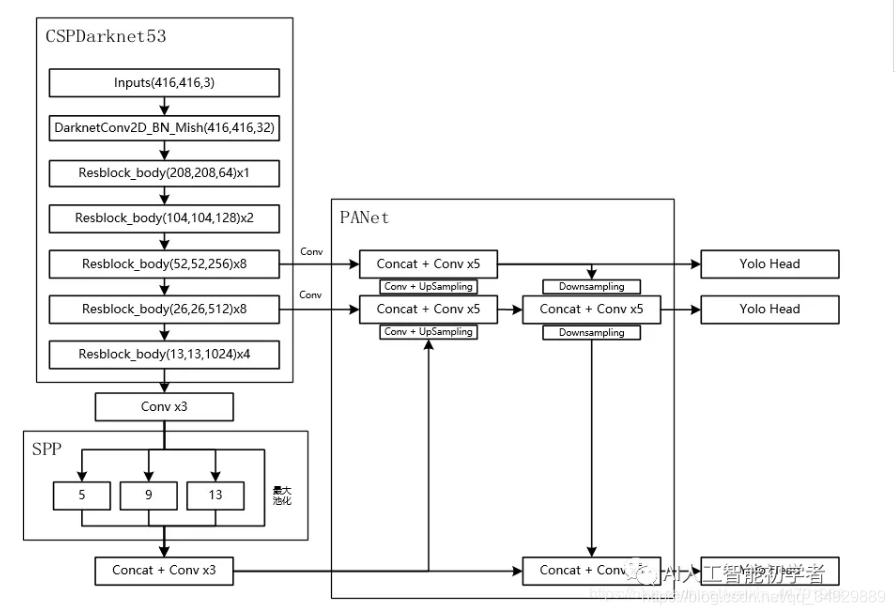从yolov5谈 Backbone neck和head
- yolov5 流程图
- resnet+fpn
yolov5 流程图

PANet实现
class YoloBody(nn.Module):def __init__(self, num_anchors, num_classes):super(YoloBody, self).__init__()# backboneself.backbone = darknet53(None)self.conv1 = make_three_conv([512,1024],1024)self.SPP = SpatialPyramidPooling()self.conv2 = make_three_conv([512,1024],2048)self.upsample1 = Upsample(512,256)self.conv_for_P4 = conv2d(512,256,1)self.make_five_conv1 = make_five_conv([256, 512],512)self.upsample2 = Upsample(256,128)self.conv_for_P3 = conv2d(256,128,1)self.make_five_conv2 = make_five_conv([128, 256],256)# 3*(5+num_classes)=3*(5+20)=3*(4+1+20)=75# 4+1+num_classesfinal_out_filter2 = num_anchors * (5 + num_classes)self.yolo_head3 = yolo_head([256, final_out_filter2],128)self.down_sample1 = conv2d(128,256,3,stride=2)self.make_five_conv3 = make_five_conv([256, 512],512)# 3*(5+num_classes)=3*(5+20)=3*(4+1+20)=75final_out_filter1 = num_anchors * (5 + num_classes)self.yolo_head2 = yolo_head([512, final_out_filter1],256)self.down_sample2 = conv2d(256,512,3,stride=2)self.make_five_conv4 = make_five_conv([512, 1024],1024)# 3*(5+num_classes)=3*(5+20)=3*(4+1+20)=75final_out_filter0 = num_anchors * (5 + num_classes)self.yolo_head1 = yolo_head([1024, final_out_filter0],512)def forward(self, x):# backbonex2, x1, x0 = self.backbone(x)P5 = self.conv1(x0)P5 = self.SPP(P5)P5 = self.conv2(P5)P5_upsample = self.upsample1(P5)P4 = self.conv_for_P4(x1)P4 = torch.cat([P4,P5_upsample],axis=1)P4 = self.make_five_conv1(P4)P4_upsample = self.upsample2(P4)P3 = self.conv_for_P3(x2)P3 = torch.cat([P3,P4_upsample],axis=1)P3 = self.make_five_conv2(P3)P3_downsample = self.down_sample1(P3)P4 = torch.cat([P3_downsample,P4],axis=1)P4 = self.make_five_conv3(P4)P4_downsample = self.down_sample2(P4)P5 = torch.cat([P4_downsample,P5],axis=1)P5 = self.make_five_conv4(P5)out2 = self.yolo_head3(P3)out1 = self.yolo_head2(P4)out0 = self.yolo_head1(P5)return out0, out1, out2resnet+fpn
class YoloV6(nn.Module):def __init__(self, cfg, ch=3):super(YoloV6, self).__init__()with open(cfg) as f:self.md = yaml.load(f, Loader=yaml.FullLoader)self.nc = self.md['nc']self.anchors = self.md['anchors']self.na = len(self.anchors[0]) // 2 # number of anchorsself.backbone = resnet18()self.backbone = IntermediateLayerGetter(self.backbone, {
'layer2': 0, 'layer3': 1, 'layer4': 2})# FPNin_channels = [128, 256, 512]self.fpn = FeaturePyramidNetwork(in_channels_list=in_channels, out_channels=256)self.detect = Detect(self.nc, self.anchors, [256, 256, 256])# forward to get Detect lay params dynamicallys = 512 # 2x min strideself.detect.stride = torch.tensor([s / x.shape[-2] for x in self.forward(torch.zeros(1, ch, s, s))]) # forwardself.detect.anchors /= self.detect.stride.view(-1, 1, 1)check_anchor_order(self.detect)self.stride = self.detect.strideself._initialize_biases()initialize_weights(self)# for compatible, in check_anchors in train.pyself.model = [self.detect]def _initialize_biases(self, cf=None):m = self.detect # Detect() modulefor mi, s in zip(m.m, m.stride): # fromb = mi.bias.view(m.na, -1) # conv.bias(255) to (3,85)# obj (8 objects per 640 image)b[:, 4] += math.log(8 / (640 / s) ** 2)b[:, 5:] += math.log(0.6 / (m.nc - 0.99)) if cf is None else torch.log(cf / cf.sum()) # clsmi.bias = torch.nn.Parameter(b.view(-1), requires_grad=True)def forward(self, x, augment=False):# we not using augment at allfeas = self.backbone(x)a = self.fpn(feas)# for k, v in a.items():# print(k, v.shape)x_s, x_m, x_l = a[0], a[1], a[2]# print('p3 ', p3.shape)# print('p4 ', p4.shape)# print('p5 ', p5.shape)# print('feas ', feas.shape)# x_s, x_m, x_l = self._build_head(p3, p4, p5, feas)x = self.detect([x_s, x_m, x_l])return xdetect实现
class Detect(nn.Module):stride = None # strides computed during buildexport = False # onnx exportdef __init__(self, nc=80, anchors=(), ch=()): # detection layersuper(Detect, self).__init__()self.nc = nc # number of classesself.no = nc + 5 # number of outputs per anchorself.nl = len(anchors) # number of detection layersself.na = len(anchors[0]) // 2 # number of anchorsself.grid = [torch.zeros(1)] * self.nl # init grida = torch.tensor(anchors).float().view(self.nl, -1, 2)self.register_buffer('anchors', a) # shape(nl,na,2)self.register_buffer('anchor_grid', a.clone().view(self.nl, 1, -1, 1, 1, 2)) # shape(nl,1,na,1,1,2)self.m = nn.ModuleList(nn.Conv2d(x, self.no * self.na, 1) for x in ch) # output convself.anchor_grid_awesome = torch.tensor(anchors).to(device).view(self.nl, 1, -1, 1, 1, 2)def forward(self, x):# x = x.copy() # for profilingz = [] # inference output# self.training |= self.exportfor i in range(self.nl):x[i] = self.m[i](x[i]) # convif self.export:print('exporting...')s = x[i].shapebs, _, ny, nx = s # x(bs,255,20,20) to x(bs,3,20,20,85)x_i = x[i]x_i = x_i.view(bs, self.na, self.no, ny, nx).permute(0, 1, 3, 4, 2).contiguous()else:bs, _, ny, nx = x[i].shape # x(bs,255,20,20) to x(bs,3,20,20,85)x[i] = x[i].view(bs, self.na, self.no, ny, nx).permute(0, 1, 3, 4, 2).contiguous()if not self.training or self.export: # inference if self.export:self.grid = [i.to(x_i.device) for i in self.grid]self.a = self.anchor_grid_awesome[i]if self.grid[i].shape[2:4] != x_i.shape[2:4]:self.grid[i] = self._make_grid(nx, ny).to(x_i.device)y = x_i.sigmoid()print('[WARN] you are calling export...')x1y1, x2y2, conf, prob = torch.split(y, [2, 2, 1, self.nc], dim=4)x1y1 = ((x1y1*2. - 0.5 + self.grid[i].to(x_i.device)) * self.stride[i]).type(x_i.dtype)x2y2 = (x2y2 * 2) ** 2 * self.axyxy = torch.cat((x1y1, x2y2), dim=4)# # add a idx (label ids before prob)idxs = torch.argmax(prob, dim=-1).unsqueeze(axis=-1).type(x_i.dtype).to(x_i.device)y = torch.cat((xyxy, conf, idxs, prob), dim=4).to(x_i.device)# we added idxs so no+1z.append(y.view(bs, -1, self.no+1))else:if self.grid[i].shape[2:4] != x[i].shape[2:4]:self.grid[i] = self._make_grid(nx, ny).to(x[i].device)y = x[i].sigmoid()y[..., 0:2] = (y[..., 0:2] * 2. - 0.5 + self.grid[i].to(x[i].device)) * self.stride[i] # xyy[..., 2:4] = (y[..., 2:4] * 2) ** 2 * self.anchor_grid[i] # whz.append(y.view(bs, -1, self.no))if self.training:return x if self.training else (torch.cat(z, 1), x)elif self.export:return torch.cat(z, 1)else:return (torch.cat(z, 1), x)@staticmethoddef _make_grid(nx=20, ny=20):yv, xv = torch.meshgrid([torch.arange(ny), torch.arange(nx)])return torch.stack((xv, yv), 2).view((1, 1, ny, nx, 2)).float()